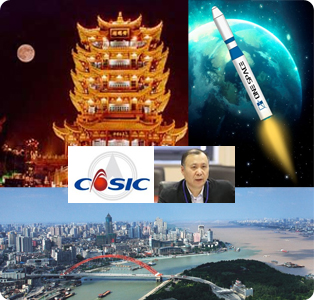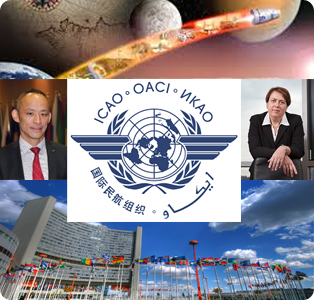China Independent Commercial Space Forum Engaging International Participation
|
MONDAY Ongoing…
|

![]() = All times
= All times
for terrestrial events in local time unless noted.
![]() = All times for international terrestrial events in local time unless noted.
= All times for international terrestrial events in local time unless noted.
![]() = All times for space events, and…
= All times for space events, and…
![]() = All times for international space / astro events in Hawaii Standard Time unless noted. Add 10 hours to obtain UT (‘Universal Time;’ Greenwich, England).
= All times for international space / astro events in Hawaii Standard Time unless noted. Add 10 hours to obtain UT (‘Universal Time;’ Greenwich, England).
Weekly Planet Watch – Evening Planets: Jupiter (WSW), Saturn (SSW), Uranus (E), Neptune (SE); Morning Planets: Venus (E).
United Nations Hosts Aerospace Symposium in Austria
The 3rd ICAO/UNOOSA Aerospace Symposium (SPACE2017) is scheduled August 29-31 at the Vienna International Centre in Austria on the theme Emerging Space Activities and Civil Aviation Challenges and Opportunities. Participants gain perspectives on latest trends in aviation, space activities, commercial space transportation and suborbital operations; sustainability of aerospace activities; regulatory and practical perspectives for aerospace operations and cooperation and coordination with aerospace stakeholders; and air traffic management & future space traffic management. A diverse program includes representatives from across Europe as well as USA, Canada, Japan, China, UAE, and Lebanon. Welcoming remarks will be given by UNOOSA Director Simonetta Di Pippo, ICAO Air Navigation Commission President Hajime Yoshimura and UAE Space Agency Director General Mohammed Nasser Alahbabi. This is the culmination of a 3 part series of Aerospace Symposiums that started in Montréal, Canada in 2015, then Abu Dhabi, United Arab Emirates in 2016. International Civil Aviation Organization is a United Nations Specialized Agency formed in 1944 now working with 191 Member States focused on Standards and Recommended Practices to support safe, efficient, secure, economically sustainable and environmentally responsible civil aviation, and increasingly, space transportation. United Nations Office for Outer Space Affairs works to promote international cooperation in the peaceful use and exploration of space, and in the utilization of space science and technology for sustainable economic and social development. (Image Credit: ICAO, ESA, UNOOSA) |
Continued from…
|
TUESDAY
![]() Aug 29 — NASA, NASA HQ, Washington DC / Online: Cassini End-of-Mission media teleconference to overview science and operations activities of final orbits; led by Curt Niebur, Cassini program scientist.
Aug 29 — NASA, NASA HQ, Washington DC / Online: Cassini End-of-Mission media teleconference to overview science and operations activities of final orbits; led by Curt Niebur, Cassini program scientist.
![]() Aug 29 — JPL, Pasadena CA / Online: Voting for #MessageToVoyager campaign ends today at 14:00; winning entry to be beamed to interstellar space on September 5.
Aug 29 — JPL, Pasadena CA / Online: Voting for #MessageToVoyager campaign ends today at 14:00; winning entry to be beamed to interstellar space on September 5.
![]() Aug 29-30 — China Aerospace Science & Industry Corporation (CASIC) China Aerospace Science & Technology Corporation (CASC), China Electronic Technology Group Corporation (CETC), China Space Foundation (CSF), Chinese Society of Astronautics (CSA), Wuhan, Hubei, China: 3rd China (International) Commercial Space Forum.
Aug 29-30 — China Aerospace Science & Industry Corporation (CASIC) China Aerospace Science & Technology Corporation (CASC), China Electronic Technology Group Corporation (CETC), China Space Foundation (CSF), Chinese Society of Astronautics (CSA), Wuhan, Hubei, China: 3rd China (International) Commercial Space Forum.
![]() Aug 29-31 — International Civil Aviation Organization, United Nations Office of Outer Space Affairs, Vienna, Austria: ICAO/UNOOSA Aerospace Symposium (SPACE 2017).
Aug 29-31 — International Civil Aviation Organization, United Nations Office of Outer Space Affairs, Vienna, Austria: ICAO/UNOOSA Aerospace Symposium (SPACE 2017).
![]() Aug 29 — Moon: 9.6° N. of Antares, 06:00.
Aug 29 — Moon: 9.6° N. of Antares, 06:00.
WEDNESDAY
![]() Aug 30 — ISS, 330-435-km LEO: Record-breaking Astronaut Peggy Whitson hosts news conference from orbit ahead of her return to Earth (September 15); airing live on NASA TV, 07:00.
Aug 30 — ISS, 330-435-km LEO: Record-breaking Astronaut Peggy Whitson hosts news conference from orbit ahead of her return to Earth (September 15); airing live on NASA TV, 07:00.
![]() Aug 30 — Van Allen Probes, LEO: Spacecraft begin 6th year in space today, launched 2012; adding to the understanding of Earth radiation belt environment and its variability.
Aug 30 — Van Allen Probes, LEO: Spacecraft begin 6th year in space today, launched 2012; adding to the understanding of Earth radiation belt environment and its variability.
![]() Aug 30 – Sep 1 — Lund University, Lund, Sweden: Meeting: The Science of Gaia and Future Challenges.
Aug 30 – Sep 1 — Lund University, Lund, Sweden: Meeting: The Science of Gaia and Future Challenges.
![]() Aug 30 – Sep 2 — UCLA, Chinese Academy of Sciences, Jamia Millia Islamia University, Lanzhou, China: Conference: Shedding Light on the Dark Universe with Extremely Large Telescopes.
Aug 30 – Sep 2 — UCLA, Chinese Academy of Sciences, Jamia Millia Islamia University, Lanzhou, China: Conference: Shedding Light on the Dark Universe with Extremely Large Telescopes.
![]() Aug 30 — Moon: At apogee (distance 404,307 km), 01:25; 3.6° N of Saturn, 04:23.
Aug 30 — Moon: At apogee (distance 404,307 km), 01:25; 3.6° N of Saturn, 04:23.
THURSDAY
![]() Aug 31 — ISRO, Launch PSLV / IRNSS 1H, Satish Dhawan Space Center, Sriharikota, India: ISRO Polar Satellite Launch Vehicle, flying on PSLV-C39 mission, to launch 8th spacecraft in the Indian Regional Navigation Satellite System.
Aug 31 — ISRO, Launch PSLV / IRNSS 1H, Satish Dhawan Space Center, Sriharikota, India: ISRO Polar Satellite Launch Vehicle, flying on PSLV-C39 mission, to launch 8th spacecraft in the Indian Regional Navigation Satellite System.
![]() Aug 31 – Sep 1 — University of Groningen, Groningen, The Netherlands: Fundamentals of Life in the Universe Symposium.
Aug 31 – Sep 1 — University of Groningen, Groningen, The Netherlands: Fundamentals of Life in the Universe Symposium.
![]() Aug 31 – Sep 2 — Greece Ministry of Environment and Energy, Prince Sultan Bin Abdulaziz International Prize for Water, Rhodes, Greece: 15th International Conference on Environmental Science and Technology.
Aug 31 – Sep 2 — Greece Ministry of Environment and Energy, Prince Sultan Bin Abdulaziz International Prize for Water, Rhodes, Greece: 15th International Conference on Environmental Science and Technology.
![]() Aug 31 — Moon: 0.28° S.S.W. of comet 41P Tuttle-Giacobini-Kresak, 16:00.
Aug 31 — Moon: 0.28° S.S.W. of comet 41P Tuttle-Giacobini-Kresak, 16:00.
![]() Aug 31 — Venus: 1.4° S of Beehive Cluster, 20:08.
Aug 31 — Venus: 1.4° S of Beehive Cluster, 20:08.
![]() Aug 31 — Apollo Asteroid 2017 PQ24: Near-Earth Flyby (0.088 AU).
Aug 31 — Apollo Asteroid 2017 PQ24: Near-Earth Flyby (0.088 AU).
FRIDAY
![]() NET Sep — ISRO, Launch GSLV Mk. 2 / GSAT-6A, Satish Dhawan Space Center, Sriharikota, India: India Geosynchronous Satellite Launch Vehicle Mk. 2 to launch GSAT 6A communications satellite.
NET Sep — ISRO, Launch GSLV Mk. 2 / GSAT-6A, Satish Dhawan Space Center, Sriharikota, India: India Geosynchronous Satellite Launch Vehicle Mk. 2 to launch GSAT 6A communications satellite.
![]() Sep 1 — Deep Space: Scientists combine data from 10 deep space craft to study progression of a single Coronal Mass Ejection: Venus Express, Stereo-A traveling ahead of Earth in its orbit, Mars Express, Mars Odyssey, Maven, Curiosity Rover, Rosetta at Comet 67P/Churyumov–Gerasimenko, Cassini at Saturn, New Horizons in the Kuiper Belt and Voyager 2 travelling through interstellar space.
Sep 1 — Deep Space: Scientists combine data from 10 deep space craft to study progression of a single Coronal Mass Ejection: Venus Express, Stereo-A traveling ahead of Earth in its orbit, Mars Express, Mars Odyssey, Maven, Curiosity Rover, Rosetta at Comet 67P/Churyumov–Gerasimenko, Cassini at Saturn, New Horizons in the Kuiper Belt and Voyager 2 travelling through interstellar space.
![]() Sep 1 — Juno, Jupiter Orbit: In 53-day orbital period, 8th close flyby (4,100 km) of Jupiter scheduled today.
Sep 1 — Juno, Jupiter Orbit: In 53-day orbital period, 8th close flyby (4,100 km) of Jupiter scheduled today.
![]() Sep 1 — European Southern Observatory, Garching, Germany: New Director General of ESO, Xavier Barcons, to take office today as Tim de Zeeuw completes his mandate.
Sep 1 — European Southern Observatory, Garching, Germany: New Director General of ESO, Xavier Barcons, to take office today as Tim de Zeeuw completes his mandate.
![]() Sep 1 — Amor Asteroid 3122 Florence: Near-Earth Flyby (0.047 AU); at 4-9 km diameter the largest known asteroid to flyby this close to Earth since first NEO observations by Carl Gustav Witt (Germany) and Auguste Charlois (France) of 433 Eros in 1898.
Sep 1 — Amor Asteroid 3122 Florence: Near-Earth Flyby (0.047 AU); at 4-9 km diameter the largest known asteroid to flyby this close to Earth since first NEO observations by Carl Gustav Witt (Germany) and Auguste Charlois (France) of 433 Eros in 1898.
SATURDAY
![]() Sep 2-5 — University of Cape Town, International Commission on the Middle Atmosphere (ICMA), Cape Town, South Africa: Training School on Stratosphere-Troposphere Interactions.
Sep 2-5 — University of Cape Town, International Commission on the Middle Atmosphere (ICMA), Cape Town, South Africa: Training School on Stratosphere-Troposphere Interactions.
SUNDAY
![]() Sep 3 — ISS, Soyuz MS-04 Undocking / Expedition 52 Departure, LEO: Yurchikhin, Fischer and Whitson to return to Earth, live coverage available; Whitson holds all time record for cumulative time in Space for any USA Astronaut.
Sep 3 — ISS, Soyuz MS-04 Undocking / Expedition 52 Departure, LEO: Yurchikhin, Fischer and Whitson to return to Earth, live coverage available; Whitson holds all time record for cumulative time in Space for any USA Astronaut.
![]() Sep 3-7 — UNOOSA, ESA, DLR, Joanneum Research, NPOC Space Law University of Vienna, Graz University of Technology, Austrospace, Municipality of Graz, Graz, Austria: United Nations / Austria Symposium on Access to Space: Holistic Capacity-Building for the 21st Century.
Sep 3-7 — UNOOSA, ESA, DLR, Joanneum Research, NPOC Space Law University of Vienna, Graz University of Technology, Austrospace, Municipality of Graz, Graz, Austria: United Nations / Austria Symposium on Access to Space: Holistic Capacity-Building for the 21st Century.
![]() Sep 3-9 — University of Rome, University of Pisa, Viterbo, Italy: 7th Meeting on Celestial Mechanics.
Sep 3-9 — University of Rome, University of Pisa, Viterbo, Italy: 7th Meeting on Celestial Mechanics.
![]() Sep 3 — Moon: 1.5° S.S.E. of comet Schwassmann-Wachmann 1, 22:00.
Sep 3 — Moon: 1.5° S.S.E. of comet Schwassmann-Wachmann 1, 22:00.

